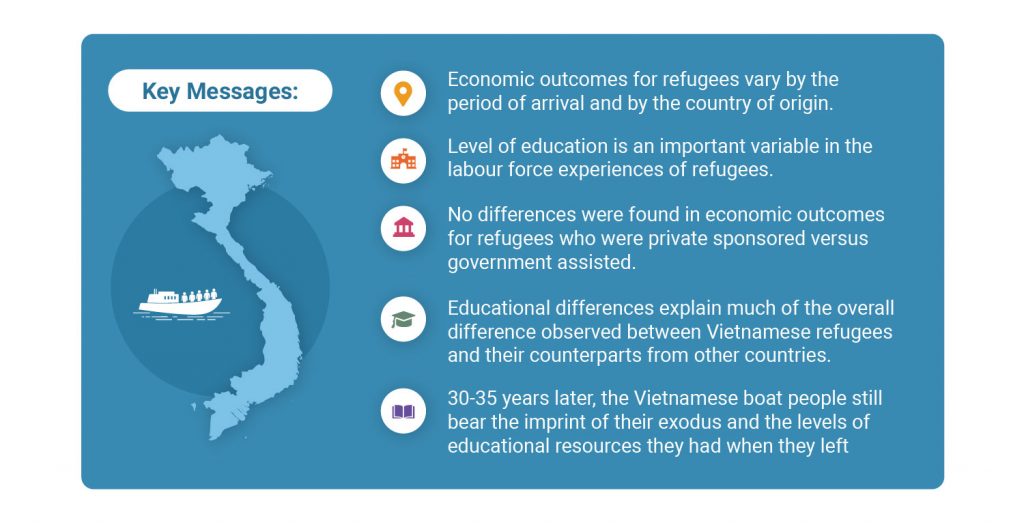A Retrospective Look: The Social and Economic Integration of the Vietnamese Refugee Youth and the Second Generation in Contemporary Canada
Researchers: Monica Boyd, Shawn Perron, and Lei Chai
Affiliation: University of Toronto
Keywords: Vietnamese refugees, Indochinese refugees, Boat People, refugee children, refugee youth, sponsored refugees, entry category, educational attainment, labour market, integration, earnings, occupations, quantitative research
Jump to: Full Infographic, Methodology, Findings, Publications & Reports
Summary
Objective: This project asked how well the Vietnamese population welcomed to Canada between 1979-1981, colloquially labeled “the Boat People,” are doing today with respect to educational attainment and labour market integration (measured in terms of occupation and earnings).
Justification: Canada’s reaction to the Vietnamese refugees is sometimes framed as an ideal blueprint for addressing the Syrian refugee crisis, yet there is very little information on the social and economic integration of the children of Vietnamese refugees or those who arrived in Canada as children (the second and 1.5 generations).
Practical goal: This study provides a better understanding of the social mobility of refugee children and second-generation children born to refugee parents from war-torn countries with interrupted schooling and mental health challenges. Specifically, this study looks at second generation children, refugee children who arrived at a young age and those who arrive as adolescents – this adolescent age group is often left out of studies of refugee children and will thus provide important nuances to the refugee experience.
Primary audience: academics, policy makers, and educators
Infographic Excerpt

Methodology
This study used data from the 2011 National Household Survey (NHS) and the 2016 Census of Population to compare Vietnamese refugees to those born in China, Hong Kong, the Philippines, the United Kingdom, and in other North and Western European countries who had arrived in Canada during the same period (1979/80-1990).
This study asked the following questions:
- What are the educational attainments, language use, labour market characteristics and home ownership patterns of the children of Vietnamese refugees?
- Do specific entry and birth cohorts experience different social and economic outcomes, that is, do outcomes differ for those arriving as children, as older adolescents, and those born in Canada?
- How do these outcomes compare to those of children with parents from other countries as well as to the white Canadian born population?
Findings
- This study found that economic outcomes for refugees varied by period of arrival and country of origin. Education is an important explanation for the labour force experiences of refugees. Differences between groups that immigrated during the 1979-1990 period in occupational status, the percentage holding high skilled occupations, and 2015 earnings largely reflect educational differences between groups. A great deal of the occupational and earnings disadvantages of the Vietnamese-born group are caused by low levels of education. For refugee children and adolescents, education was also the main predictor of occupational attainment and earnings. Additional education and strategies for keeping children in school longer may be helpful for improving economic outcomes later in life.
- Comparing the adult refugees from Vietnam, Cambodia, and Laos arriving between 1980-1990, this study found no differences between those entering as privately sponsored refugees (PSRs) versus government assisted refugees (GARs).
- Refugee accommodation is a long-term on-going process. Some 30-35 years later, the Vietnamese boat people still bear the imprint of their exodus and the levels of educational resources they had when they left Vietnam.
Explore more projects


